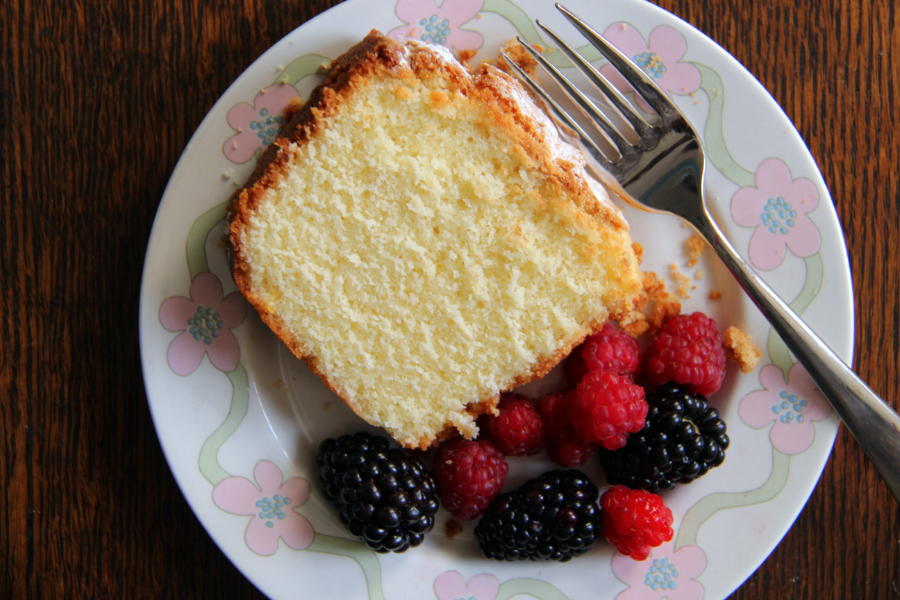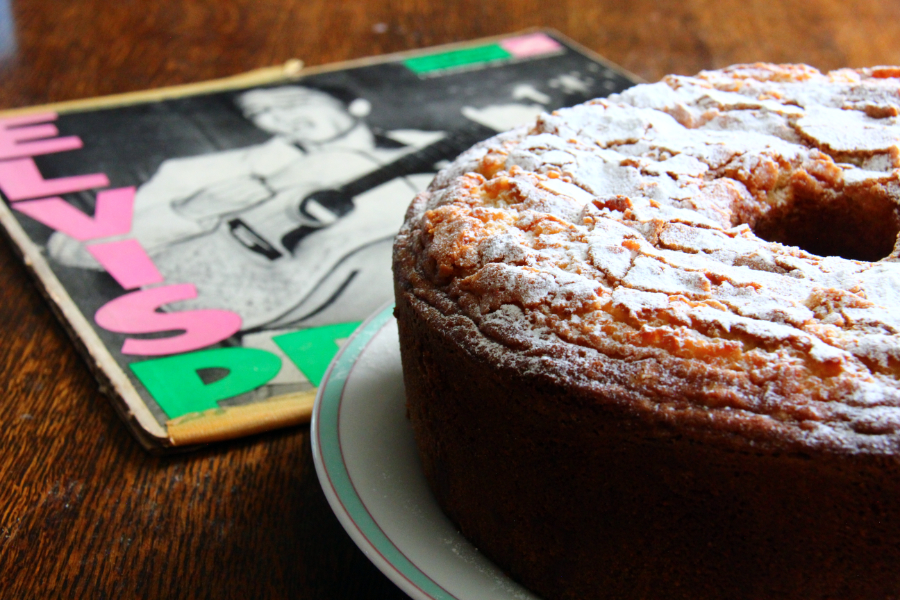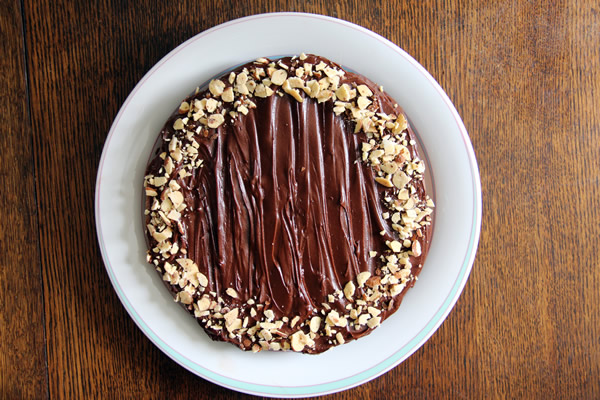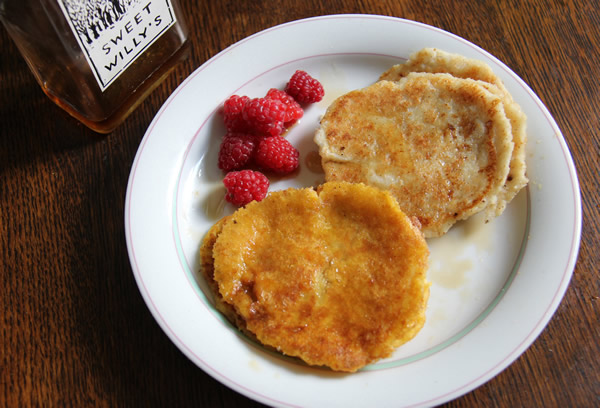
When I told my brother Mitchell that I’d baked Elvis’s Presley’s Favorite Pound Cake, he sang, “You ate nothin’ but a pound cake.” Not just any pound cake, but the King of Pound Cakes.
Moist and tender, this golden cake owes its richness and height to heavy cream, butter and lots of eggs. Cake flour makes it light and silky. Of course, you would guess that Elvis’s cake would be over-the-top luxurious. You can’t help falling in love with it.
This hint-of-lemon adaptation comes from Leah Greenwald, Recipephany’s Celebrity Cake Consultant and baking inspiration. She compared this to Sara Lee’s packaged pound cake—a favorite in my household when I was growing up. “It has a texture very similar to Sara Lee’s, but a more nuanced flavor,” she said. When she added that Elvis’s “tastes sinfully great,” I knew I had to try it—and it was now or never.
Leah clipped the recipe from Gourmet Magazine’s September 2005 “Music Issue,” subtitled “Where music meets food.” The team of Jane and Michael Stern, famous for their Roadfood books, nostalgized lovingly about this recipe as well as the one for Elvis’s legendary hot peanut butter and banana sandwich. But unlike the sandwich, this cake went on to become one of Gourmet’s most popular recipes. The Sterns called it “hands down, the best pound cake ever.”
The Sterns scored this recipe straight from the source: Elvis’s old childhood friend Janelle McComb from Tupelo, Mississippi. The story goes that every Christmas she’d bake him two cakes and bring them to Graceland. Elvis would set aside one to eat all by himself and share the other with his entourage. On the 10th anniversary of Elvis’s death, in 1987, she handed over the recipe to the Sterns.
Leah pointed out a few quirky instructions in the original recipe. It called for sifting, a relic from the past. Leah recommends passing the flour through a wire mesh sieve to approximate the aeration that comes with sifting. And the cake starts out in a cold oven. This helps make a crispy, caramelized crust—a delicious bonus.
A simple thing like greasing the pan also makes a big difference. Leah recommends using Baker’s Joy baking spray just before adding the batter—not earlier—in order to have the best chance of a clean release.
And we know how tricky releasing a cake from a bundt pan can get. Since we like to keep that crispy crust on top rather than flipped over to the bottom, we opt for a heavyweight tube pan instead of a bundt pan. We picked up a Nordic Ware 18-cup pound cake/angel food cake pan at a thrift store recently and like its large capacity, straight sides and lack of nooks and crannies. Even though it has a nonstick finish, we still need to give it a heavyweight greasing and line the bottom with parchment paper.
But even if choose to make this heavenly pound cake your own way, think of Elvis and hear him sing, “Well, that’s all right, mama, anyway you do.”
Read the original Gourmet recipe at Saveur.
Shown above: Original album cover, “Elvis Presley,” his recording debut on RCA Victor Records released March 23, 1956. Courtesy of Miriam Modricamin.
Elvis’s Favorite Pound Cake
Suggested equipment:
10-inch tube pan (4½ inches deep, not with a removable bottom), or a 10-inch bundt pan (3¼ inches deep, 3-qt capacity), or 2 loaf pans; a medium wire mesh sieve
- 2 sticks (1 cup) unsalted butter, softened
- 3 cups cake flour
- ¾ teaspoon salt
- 3 cups sugar
- 7 large eggs, at room temperature
- 1 tablespoon vanilla
- Finely-grated rind of one lemon
- 1 cup heavy cream
For prepping pan:
Baker’s Joy Spray, homemade Cake Goop, or a mixture of 1 tablespoon all purpose flour and 1½ tablespoons melted butter
- Put oven rack in middle position, but do not preheat oven.
- Measure flour by spooning it lightly into a measuring cup. Pass the measured flour through a medium wire mesh sieve into a bowl to aerate it and remove any clumps.
- Remove a couple of tablespoons of flour and put it into a small bowl. Grate the lemon rind over it and toss. Set aside.
- In a large bowl, beat together butter and sugar with an electric mixer at medium-high speed until pale and fluffy. This takes about 5 minutes using a stand mixer with paddle attachment, or 6 to 8 minutes with a handheld mixer.
- Add eggs, one at a time, beating well after each addition, then beat in vanilla. Reduce speed to low and add half of flour, then all of cream, then remaining flour, mixing well after each addition.
- Sprinkle rind/flour mixture over batter and stir to distribute. Scrape down side of bowl, then beat at medium-high speed 5 minutes. Batter will become creamier and satiny.
- At this point, spray pan with Baker’s Joy or brush with Cake Goop. Or, brush it with the mixture of flour and melted butter. If using a tube pan, line bottom with parchment paper. Prepping the pan now, just before spooning in the batter, assures a better chance for a clean release.
- Spoon batter into pan and rap pan against work surface once or twice to eliminate air bubbles. Place pan in cold oven and turn oven temperature to 350°F. Bake until golden and a wooden pick or skewer inserted in middle of cake comes out with a few crumbs adhering, 1 to 1¼ hours.
- Cool cake in pan on a rack 30 minutes. Run a thin knife around inner and outer edges of cake to release it.
- If using a tube pan, invert the cake twice so that it ends right-side-up on a plate. This way the crisp crust remains on top.* If using a bundt pan, invert the pan once to cool on a rack; the crust will be on the bottom. Cool cake completely.
- Dust with confectioners’ sugar and serve with fresh berries or fruit.
*Alternatively, if you want the crispy crust and don’t have a tube pan, you can bake the cake in two loaf pans lined with double parchment slings. That way you can lift them directly out of the pans without inverting, and then cool them on a rack.








2 Comments
Judith
What a cake thank You
Diane Brody
Thanks, Judith! It is pretty amazing. I have my friend Leah to thank for finding it. Glad you like it.
Best,
Diane